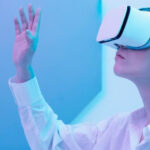
In recent years, technological advancements have led to significant changes in the way we interact with digital content and experience the world around us. Two emerging devices that are reshaping the landscape of personal computing are smartphones and augmented reality (AR) glasses. While smartphones have become an integral part of our daily lives, AR glasses offer a glimpse into a future where digital information seamlessly integrates with our physical surroundings. In this blog post, we’ll explore the key differences, advantages, and potential applications of smartphones vs AR glasses, as well as the implications for the future of personal computing.
Portability and Convenience
Smartphones have become ubiquitous due to their compact size and portability. They fit comfortably in our pockets, allowing us to access a wealth of information and perform various tasks on the go. With powerful processors, high-resolution displays, and versatile apps, smartphones have transformed into multifunctional devices capable of communication, entertainment, productivity, and more.
On the other hand, AR glasses hold the promise of a hands-free and immersive computing experience. By wearing AR glasses, users can overlay digital content onto their real-world environment, enhancing their perception and interaction with the surroundings. AR glasses eliminate the need to constantly hold a device, freeing up our hands for other tasks. However, the current challenge for AR glasses lies in achieving a balance between comfort, battery life, and processing power, making them less convenient for everyday use compared to smartphones.
Augmented Reality Capabilities
Smartphones have integrated basic AR features through apps and software updates. With the help of sensors like cameras and GPS, they can overlay digital information onto the real world. From gaming and social media filters to navigation and educational applications, smartphones have introduced us to the concept of augmented reality in various forms. However, the experience is limited to a small screen, requiring users to hold up their smartphones to view the augmented content.
AR glasses, on the other hand, provide a more immersive AR experience. By wearing AR glasses, users can seamlessly see and interact with digital information overlaid onto their field of view. From interactive maps and real-time translations to virtual try-on experiences and contextual information, AR glasses have the potential to transform the way we perceive and engage with our environment. They open up new possibilities for hands-free navigation, enhanced productivity, and enriched entertainment experiences.
Contextual Computing and User Experience
Smartphones excel at delivering information and services tailored to our preferences and location. With advanced sensors and connectivity options, smartphones gather data about our surroundings and utilize machine learning algorithms to provide personalized recommendations, notifications, and contextual assistance. However, the user experience is still limited to a small screen, requiring constant interaction and diverting our attention from the real world.
AR glasses have the potential to revolutionize contextual computing by seamlessly integrating digital content into our daily lives. They offer real-time, context-aware information without disrupting our field of view, providing a more natural and immersive user experience. Imagine walking down the street and instantly receiving directions, reviews, and recommendations overlaid onto the buildings and landmarks around you. AR glasses can create a personalized, information-rich environment while maintaining our connection with the physical world.
Future Applications
While smartphones continue to evolve and offer new features and capabilities, AR glasses hold immense potential for a wide range of applications. Some areas where AR glasses can make a significant impact include:
- Workforce and industrial applications: AR glasses can assist professionals in industries such as manufacturing, logistics, and healthcare, providing hands-free access to real-time information, instructions, and remote collaboration tools.
- Education and training: AR glasses can revolutionize the learning experience by overlaying interactive educational content onto real-world objects, making subjects more engaging and immersive.
- Gaming and entertainment: AR glasses can revolutionize gaming and entertainment by creating immersive and interactive experiences. Users can see virtual characters, objects, and game elements seamlessly integrated into their surroundings, bringing gaming to a whole new level of realism and interactivity.
- Healthcare and telemedicine: AR glasses can enhance medical procedures, training, and patient care by providing real-time visualizations, overlaying vital information during surgeries, and enabling remote consultations and diagnoses.
- Retail and e-commerce: AR glasses can transform the shopping experience by allowing users to try on virtual clothes and accessories, visualize furniture in their homes, and receive personalized recommendations based on their preferences and location.
- Tourism and travel: AR glasses can act as personal tour guides, providing historical and cultural information about landmarks and attractions as users explore new places. They can also offer real-time translations, navigation assistance, and augmented travel experiences.
Conclusion
While smartphones have become an integral part of our lives, AR glasses represent the future of personal computing, offering a more immersive and seamless integration of digital content with our physical environment. Smartphones excel in portability, convenience, and familiarity, while AR glasses hold the potential to transform the way we perceive, interact, and engage with the world around us.
As AR glasses continue to evolve and overcome challenges such as size, battery life, and processing power, they will likely become more mainstream and integrated into our daily lives. The applications of AR glasses are vast, spanning across industries such as healthcare, education, gaming, retail, and more, offering enhanced experiences and increased productivity.
It’s important to note that smartphones and AR glasses are not necessarily competing technologies but rather complementary devices that serve different purposes. While smartphones provide a versatile and portable computing experience, AR glasses introduce a new dimension of contextual and immersive computing.
As technology progresses, we can expect to see further advancements in both smartphones and AR glasses, creating a future where these devices coexist, catering to different needs and preferences. The choice between smartphones vs AR glasses will depend on the specific use case, personal preferences, and the level of immersion and interaction desired.
In conclusion, the ongoing advancements in smartphones and the emergence of AR glasses herald an exciting future for personal computing, where digital and physical worlds seamlessly merge, providing us with new ways to explore, learn, work, and entertain ourselves.













































Recent Comments